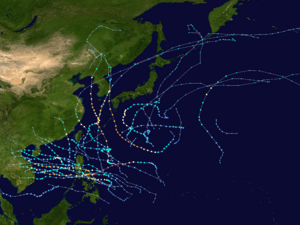2020 Pacific typhoon season facts for kids
 |
|
| Season summary map | |
| First storm formed | May 8, 2020 |
|---|---|
| Last storm dissipated | December 29, 2020 |
| Strongest storm | Goni – 905 hPa (mbar), 220 km/h (140 mph) (10-minute sustained) |
| Tropical depressions | 32 |
| Total storms | 23 |
| Typhoons | 10 |
| Super typhoons | 2 (unofficial) |
| Total fatalities | 457 total |
| Total damage | $4.06 billion (2020 USD) |
| Pacific typhoon seasons 2018, 2019, 2020, 2021, 2022 |
|
The 2020 Pacific typhoon season was a period when many strong storms, known as typhoons, formed in the Pacific Ocean. While typhoons can happen any time of year, most of them usually form between May and October. The first tropical cyclone of this season appeared on May 10, which was one of the latest starts for a typhoon season in this area.
The first big storm of the season was Typhoon Vongfong, also called Ambo. It grew into a very strong typhoon and hit the Philippines. This caused a lot of damage, especially since it happened during the COVID-19 pandemic.
What Happened During the Season

The first few months of 2020 were quiet, with no tropical storms forming until May. On May 8, the first tropical system, called Tropical Depression 01W (Ambo), began to develop. This made it the sixth-latest start to a typhoon season on record. Just two days later, this system became the first officially named tropical storm of the season, Vongfong.
Tropical Storm Vongfong quickly grew much stronger and turned into a powerful typhoon. It hit the central Philippines on May 14, making its first landfall in San Policarpo, Eastern Samar. It then crossed four more islands before reaching the main island of Luzon.
After Vongfong, the ocean became quiet again for about a month. On June 10, a new tropical depression formed near Samar, Philippines. The PAGASA (the Philippine weather agency) named it Butchoy. Butchoy made landfall in the Philippines. After it left the Philippines, Butchoy became a tropical storm in the South China Sea and was named Nuri by the Japan Meteorological Agency.
After Nuri faded away over China, the ocean was quiet again for over a month. This was the first time since records began that no tropical storms formed in July.
Activity picked up again with Tropical Storm Sinlaku. Then, Hagupit formed and became a strong typhoon, ending a two-month period without any major typhoons. Hagupit affected China and caused about US$441 million in damage. It then moved on to affect North Korea and Russia.
A few days later, Tropical Storm Jangmi formed. Close to Jangmi, another storm called Severe Tropical Storm Mekkhala formed and reached China. Soon after, Severe Tropical Storm Higos formed and became the seventh named storm of the season, also hitting China.
Then, Tropical Storm Bavi formed and quickly grew stronger near Taiwan. In late August, Typhoon Maysak formed, followed by Super Typhoon Haishen. Both of these powerful storms reached the Korean Peninsula and Japan.
September and October Storms
September began with Maysak weakening as it headed towards Korea. Meanwhile, a new Tropical Storm Haishen formed in the open Pacific. It threatened the same areas that Maysak and Bavi had affected earlier. Typhoon Maysak made landfall in both South Korea and North Korea. Typhoon Haishen became the first super typhoon of the season.
In mid-September, Tropical Storm Noul formed in the South China Sea. It made landfall in Vietnam before fading away. Later that month, Tropical Storm Dolphin formed off the coast of Japan. Near the end of September, Kujira formed and became a severe tropical storm.
October was a very busy month for storms. It started with Typhoon Chan-hom, which lasted for 14 days. On October 9, Tropical Storm Linfa formed. It was the first of many storms to affect Vietnam. Linfa sadly caused over 100 deaths and severe flooding in Vietnam and Cambodia.
Nangka formed a few days after Linfa, but its impact was not as severe. A tropical depression, called Ofel by PAGASA, moved through the Philippines and then hit Vietnam, adding to the already flooded areas.
After a short break, Typhoon Saudel formed on October 18, causing flooding in the Philippines. After Saudel, two very powerful typhoons formed: Molave and Goni. Molave sadly caused 41 deaths in the Philippines, Vietnam, and Malaysia. Goni became a Category 5-equivalent super typhoon.
After Goni, Atsani formed and brought strong winds to Northern Luzon and Southern Taiwan as a tropical storm. As Atsani faded, another storm formed and affected Visayas, named Tonyo. The next day, it became a tropical storm, earning the name Etau. Etau lasted from November 7 to November 11.
On November 8, a storm formed in the Philippine Area of Responsibility and was named Ulysses. The next day, it became a tropical storm, named Vamco. Vamco grew into a Category 2-equivalent typhoon as it passed by Luzon. It quickly left the Philippine Area of Responsibility and strengthened into a typhoon again. It rapidly became a Category 4-equivalent typhoon. It then weakened as it approached Vietnam and finally faded away north of Laos.
In December, three more storms formed, including Krovanh in the South China Sea. The season officially ended on December 29 with a weak storm near the coast of Vietnam.
Images for kids
See also
 In Spanish: Temporada de tifones en el Pacífico de 2020 para niños
In Spanish: Temporada de tifones en el Pacífico de 2020 para niños


